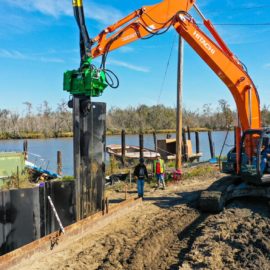
Image by CPRA
Turtles on islands make them more valuable and help getting more funding for saving them.
Sea turtle hatchlings have been spotted for the first time in at least 75 years on Louisiana’s Chandeleur Islands, state officials announced Wednesday, and the hatchlings turned out to be young versions of Kemp’s ridley turtles, the most endangered of five species found in the Gulf of Mexico. The July 29 discovery followed several months of flyovers of the rapidly eroding northern end of the island chain, which is all that remains of an ancient Mississippi River delta east of New Orleans and St. Bernard Parish in Chandeleur and Breton sounds. The research is the first step in an effort to both expand the only marine seagrass meadows in Louisiana, which dot the water on the western side of the northernmost segment of the Chandeleurs, and to possibly expand the sandy islands itself. The Chandeleurs part of the chain has shrunk from 12,000 acres to only 1,000 acres from the 1880s to present, largely as the result of repeat erosions, including major damage during Hurricane Georges in 1998 and Hurricane Katrina in 2005. Coastal Protection and Restoration Authority (CPRA) Chairman Chip Kline told members of the authority board on Wednesday that the discovery of the sea turtles will help the state go after a greater share of money related to the 2010 BP Deepwater Horizon oil spill dedicated to sea turtle recovery.
nola.com

(Google Earth)
The hurricanes did not help but the BP spill was the worse enemy of the turtles.
The BP spill is blamed for killing as many as 7,600 large juvenile and adult sea turtles and as many as 166,000 small juvenile sea turtles throughout the gulf and Gulf Coast, including in Louisiana. Another 35,000 hatchlings were believed lost due to the spill and cleanup activities on sea turtle nesting beaches, including on Grand Isle. On July 29, researchers were looking for signs of “crawls,” the tracks in sand made by turtles’ flippers when they search for nests and, after they lay eggs, return to the water. In addition to identifying 53 such tracks that researchers at first believed were made by loggerhead turtles, they found what looked like a nest cavity with tiny tracks leading to the water, said Todd Baker, CPRA project manager. When they followed the tracks, they found two hatchlings on their way to the water. A later review of photos of the hatchlings by the U.S. Fish & Wildlife Service identified both as Kemp’s ridley sea turtles, which are an endangered species. Loggerhead turtles are listed as a threatened species. State officials attribute their return to the Chandeleurs to efforts to restore the coastal habitat.

The last sighting was 75 years ago so it was a surprise to see the hatchlings.
It was the first known spotting of sea turtle hatchlings in the Chandeleurs in at least 75 years, according to the state. The Chandeleur islands are part of the Breton National Wildlife Refuge, the second refuge formed under the natural resource program created by President Theodore Roosevelt. Roosevelt visited Breton Island, at the refuge’s southern end, in 1915. The CPRA, Louisiana Department of Wildlife and Fisheries (LDWF) and U.S. Fish & Wildlife Service, which oversees the refuge, have been monitoring the Chandeleur Islands since May of this year, funded by an $8 million Deepwater Horizon oil spill natural resource recovery grant for engineering and design of restoration features. That money was dedicated to the Chandeleurs based on both the seagrass beds and the islands’ importance as a roosting location for numerous Gulf seabirds, including brown pelicans. Now that the site has been identified as a sea turtle nesting habitat, the discovery will shape future restoration plans, state officials said. “We have a responsibility to protect the wildlife here, and that means creating safe and nourishing environments for these turtles and other animals that call Louisiana home,” said CPRA Executive Director Bren Haase. “It’s an exciting discovery, and we hope to see additional hatchlings emerging in the weeks and years to come.”
Loggerhead turtles were seen on Grand Isle.
In 2015, loggerhead nests were discovered on Grand Isle, making it the first Louisiana sea turtle nesting spot in over 30 years. Kemp’s ridley turtles can be found feeding throughout Louisiana’s coastal waters. Many sea turtle species go to the Chandeleur Islands’ nearshore border of the Breton National Wildlife Refuge to feed near the state’s only marine seagrass meadows every year. “It is well known that the Chandeleur Islands provide key habitats for a host of important species; however, with the recent discovery of a successful Kemp’s ridley sea turtle hatching, the islands’ value to the region has been elevated,” said LDWF Secretary Jack Montoucet. The CPRA said that additional sea turtle nests may be found on the Chandeleur Islands. Hatchlings may be discovered well through September, since peak sea turtle nesting season is in June and July, and hatching usually occurs 50 to 60 days later. Louisiana isn’t the only Gulf Coast state seeing new sea turtle nests. The first sea turtle nest on the Mississippi mainland in four years was recently discovered.

image from the CPRA
This was good find and I hope more of the nests will be found.



